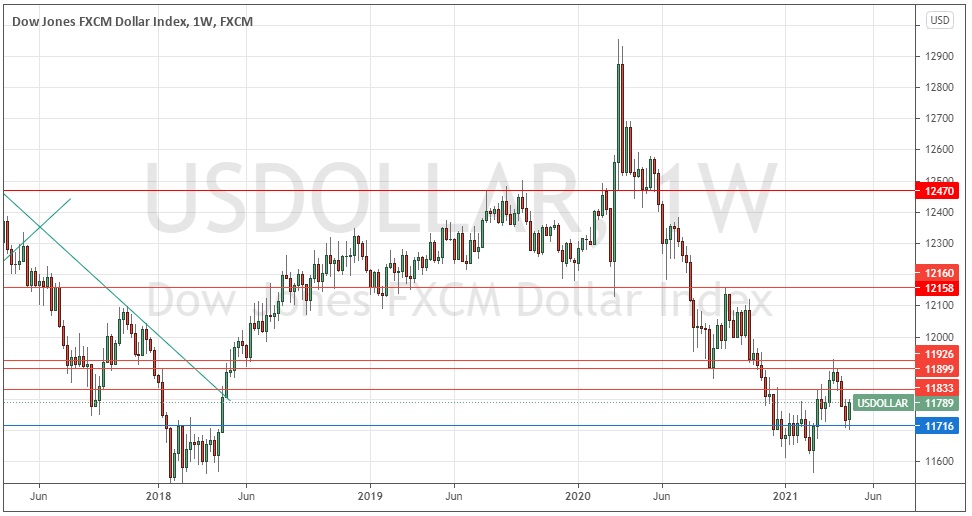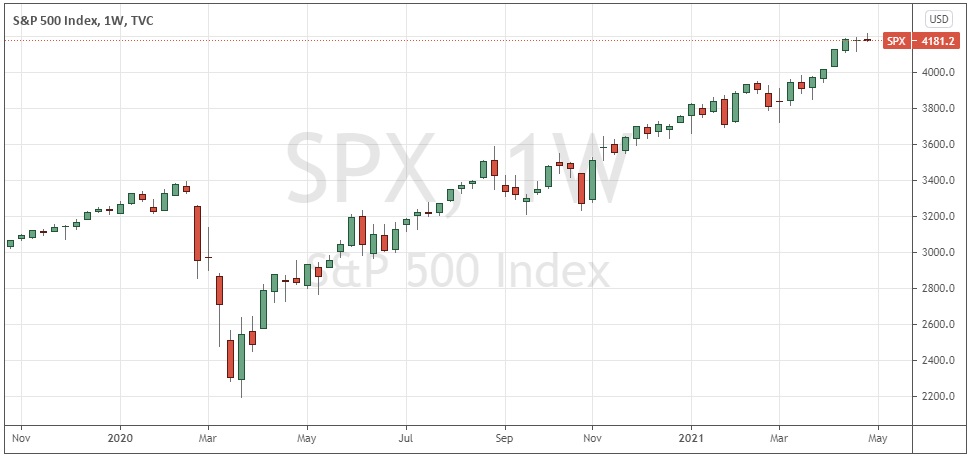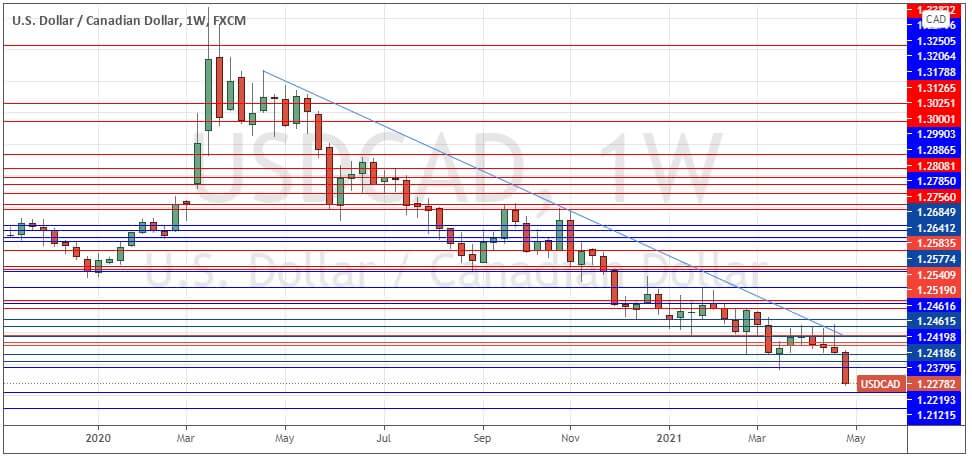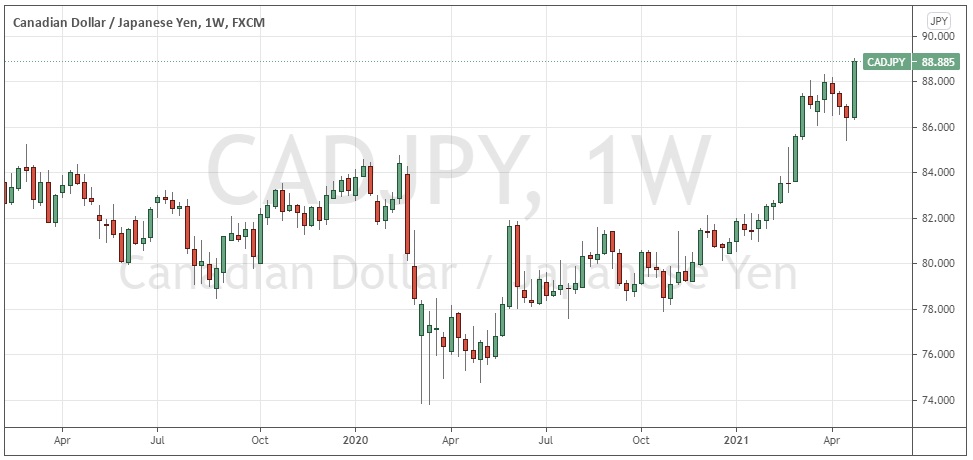The difference between success and failure in Forex trading is very likely to depend mostly upon which currency pairs you choose to trade each week and in which direction, and not on the exact trading methods you might use to determine trade entries and exits.
When starting the trading week, it is a good idea to look at the big picture of what is developing in the market as a whole and how such developments and affected by macro fundamentals and market sentiment.
It is a good time to be trading markets right now, as there are a few valid long-term bullish trends in major U.S. stock market indices which can be traded at most Forex brokers as CFDs, as well as long-term momentum in favor of the Canadian and Australian collars and against the Japanese yen.
Big Picture 2nd May 2021
Last week’s Forex market saw the strongest rise in the relative value of the Canadian dollar and the strongest fall in the relative value of the Japanese yen.
I wrote in my previous piece last week that the best trade was likely to be long of the S&P 500 following a daily (New York) close above 4200. We did not get such a close until Thursday, when the index closed at 4209.2. It ended the week the next day down at 4181, giving a loss of 0.67%.
Fundamental Analysis & Market Sentiment
The headline takeaway from last week is that market sentiment remains risk-on, especially on the U.S. which is seeing growth and payroll estimations continue to rise. Demand has been stoked by dovish monetary policies plus stimulus in the U.S., despite fears that policy will lead to untenable inflationary pressures and of higher corporate taxes. The major U.S. stock index, the S&P 500, briefly traded at a new all-time high price on Thursday above 4220.
The U.S. Dollar Index rose in value last week, although action in the Forex market was dominated by strong Canadian and Australian dollars while the Japanese yen weakened. We see long-term strength in the Canadian dollar, which is backed by fundamental factors and the policies of the Bank of Canada.
Last week’s market events calendar was dominated by monthly policy releases from the U.S. Federal Reserve, which was bullish on the booming U.S. economy, and the Bank of Japan, whose release was less immediately consequential although the Yen lost value significantly over the remainder of the week.
The main events this coming week will be the Bank of England’s monthly monetary policy release, plus U.S. Non-Farm Payrolls data. We can expect an active Forex market during the second half of this week.
Last week saw the global number of confirmed new coronavirus cases rise for the ninth consecutive week to new record highs, after falling for over two months, driven mainly by a resurgence of the virus in Asia (especially India, which is seeing very high numbers which is putting its health system under severe strain) and Latin America. The total number of global deaths also rose again last week for the sixth week running. There is considerable informed speculation that the death tally in India is perhaps double the official total running at approximately 3,500 daily, while at present there are about one million new confirmed cases every three days. There are concerns that the very high rate of infections in India could lead to the incubation of new mutations resistant to vaccines, although Pfizer is optimistic that their current vaccine offers a very high level of protection against any mutations identified so far.
Many countries have begun vaccination programs. Excepting extremely small nations, the fastest progress towards herd immunity has taken place in Israel, the U.K. and the U.A.E. Immunization is proceeding quickly in the U.S. and the European Union has finally begun to quicken the pace of its program sufficiently to begin to make a difference.
The strongest growth in new confirmed coronavirus cases is happening in Afghanistan, Algeria, the Bahamas, Bahrain, Bolivia, Cambodia, Colombia, Egypt, Georgia, India, Japan, Kazakhstan, Laos, Latvia, Lithuania, Malaysia, Nepal, Saudi Arabia, Trinidad, and Uzbekistan.
Technical Analysis
U.S. Dollar Index
The weekly price chart below shows the U.S. Dollar Index printed a bullish engulfing candlestick last week after rejecting a new key support level printed at 11716. This is a bullish sign. The index is now above its price from three months ago, which is a bullish sign, but is still below its price from six months ago, suggesting bullish momentum is developing but is still somewhat unreliable. Overall, next week’s price movement in the U.S. dollar looks slightly likely to be upwards. For this reason, it will probably be wise to not take any short USD trades over the coming week, except in very strong currencies such as the Canadian dollar.
S&P 500 Index
The incredible rise of the U.S. stock market since the initial impact of the coronavirus in March 2020 seems to be making a small pause, with the price mostly holding its ground last week to briefly trade Thursday at another all-time high. This was really a pause in the recent strong rise, so bulls will probably do well to be a little careful here and wait for a daily close above 4220 before looking to get long again. Above that level, the price will be in blue sky with bullish momentum, which would suggest the rise would then be likely to continue for some days.
USD/CAD
Although the Canadian dollar does not have a good track record of respecting its own price momentum, the chart below shows we have seen a firm and persistent long-term bullish trend in the Loonie ever since the initial recovery from the coronavirus price shock of March 2020. Last week saw a strong bullish candlestick which closed right on the low of its range, with this currency pair now at a three-year low price. We can therefore say there is a strong long-term bearish trend, although bears should be cautious of 1.2250 which was a bullish inflection point the last time the price reached it.
CAD/JPY
The Canadian dollar is covered above in USD/CAD, but it should be noted that the Loonie is also breaking to long-term highs against the Japanese yen, which is currently much weaker than the USD. This means the CAD/JPY currency cross may be the best vehicle right now to exploit strength in the Canadian dollar, after last week produced a strong bullish engulfing candle which took out the real bodies of the previous three weeks of candlesticks.
Bottom Line
I see the best likely opportunity in the financial markets this week as being long of the Canadian dollar against the Japanese yen, and long of the S&P 500 Index following a daily (New York) close above 4220.





